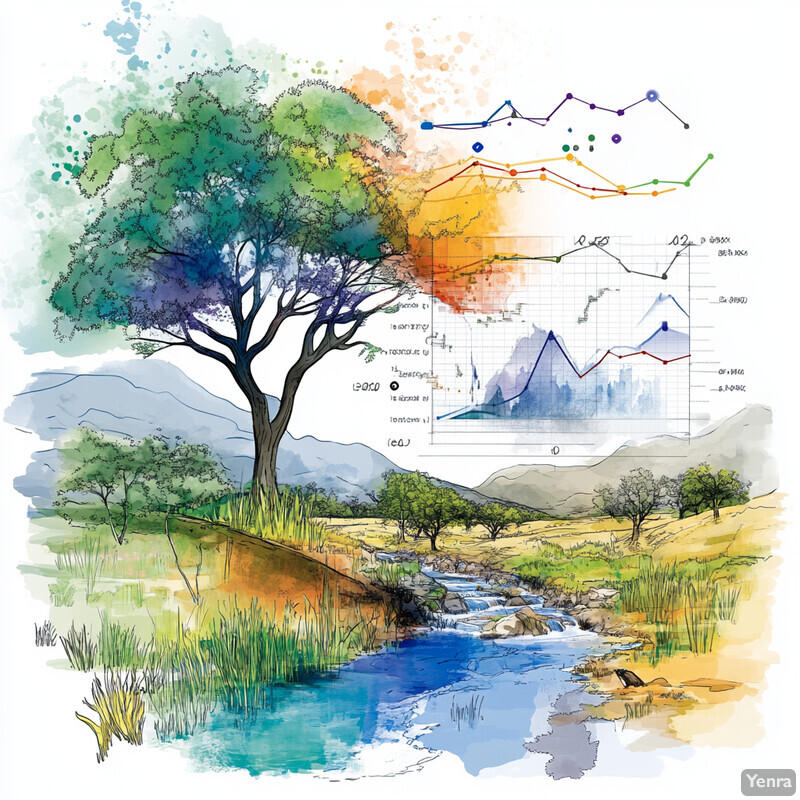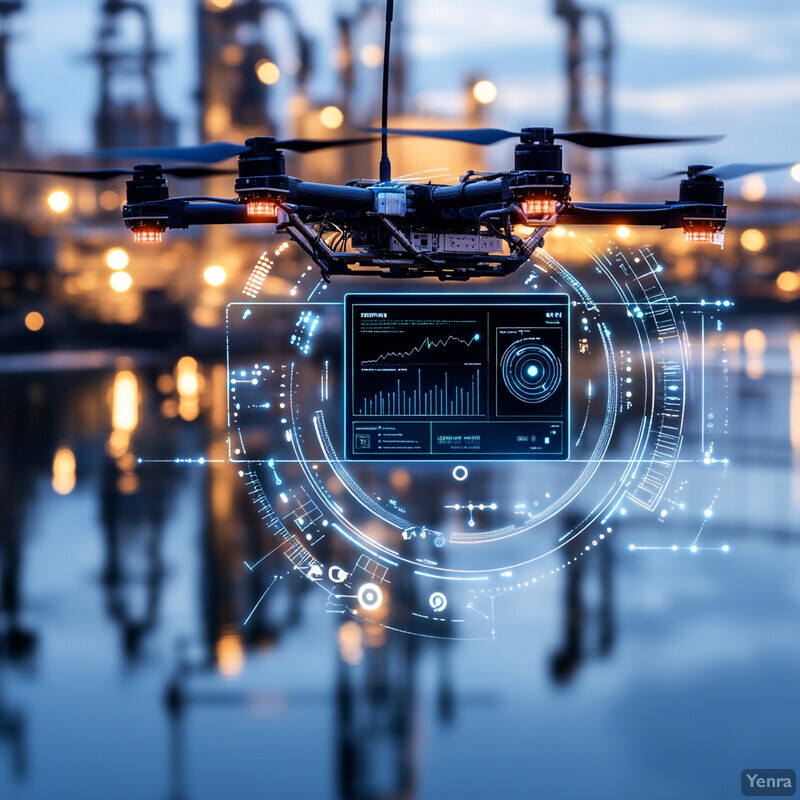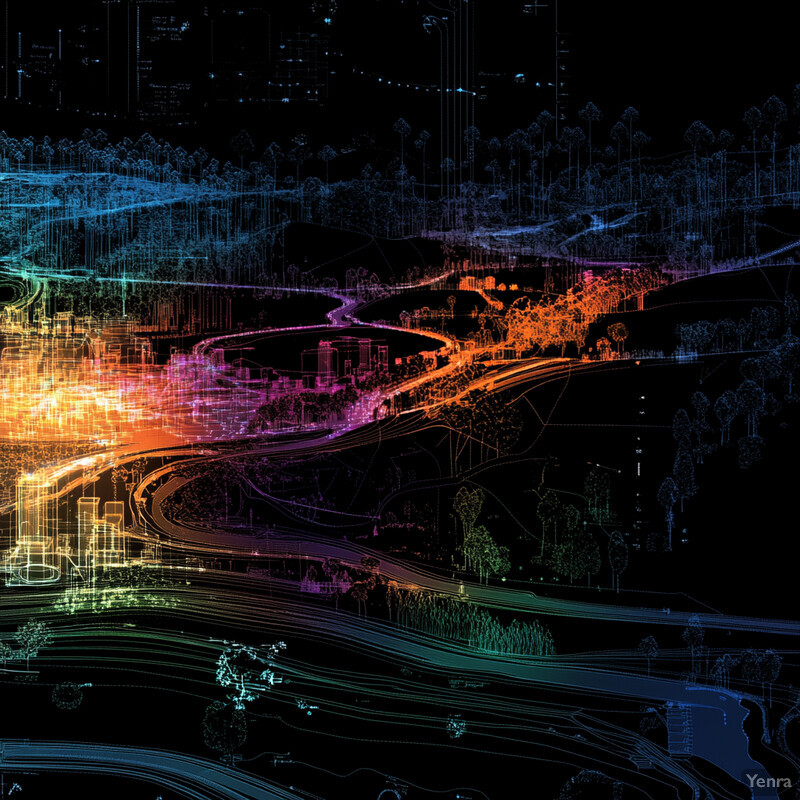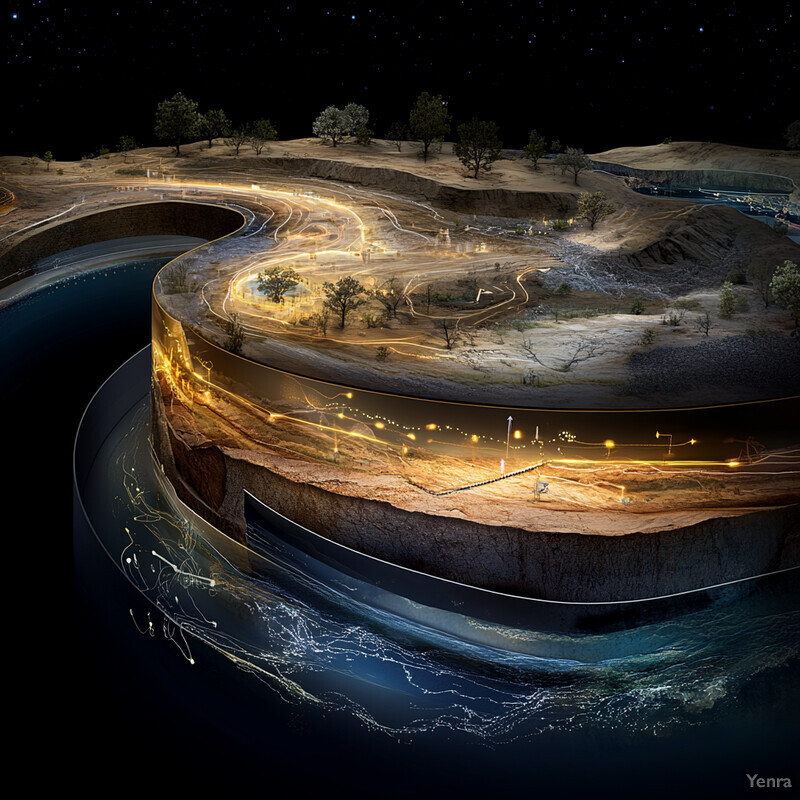1. Enhanced Remote Sensing Analysis
Artificial intelligence is transforming how we interpret remote sensing data (satellite, aerial, and drone imagery) for EIAs. AI-driven image recognition algorithms automatically classify land cover and detect changes (like deforestation or urban sprawl) that once required slow manual analysis. This improves consistency and speed: decision-makers can get near-real-time updates on land use changes. By catching subtle environmental shifts early, planners can better establish baseline conditions and spot potential impacts to address. Overall, AI makes remote sensing more efficient and nuanced, enabling more informed and timely environmental assessments.

AI models have achieved very high accuracy and efficiency in image analysis. For example, deep learning CNNs have exceeded 90% accuracy in land cover classification for remote sensing images. In practice, this has cut analysis times dramatically: tasks that once took human experts days can now be done in minutes. One industry case study by Maxar showed that combining 15 cm high-resolution satellite imagery with machine learning greatly improved detection of small features (like solar panels) on the landscape. Moreover, AI can handle huge data volumes in real-time – as one expert noted, these algorithms allow analysts to “find mission-critical information” fast, driving down the latency from sensor to decision. This means EIAs can incorporate up-to-date land use data with unprecedented speed and detail, enhancing the accuracy of environmental impact evaluations.
2. Predictive Modeling of Ecosystem Impacts
AI enables more powerful predictive modeling of how projects might affect ecosystems in the future. Machine learning models can integrate diverse data (historical trends, climate forecasts, species data) to simulate potential ecological outcomes of a proposed development. This helps analysts explore scenarios: e.g. how a dam could alter fish populations or how climate change might exacerbate a project’s impacts. Such AI-driven models produce probabilistic forecasts of impacts on habitats, wildlife, or water resources with greater accuracy. This foresight allows stakeholders to proactively design mitigation strategies. In essence, AI’s predictive strength means EIAs are no longer just static snapshots – they can be forward-looking tools that anticipate and avert ecological harm.

AI-based predictive tools are already demonstrating success. For instance, WWF’s Forest Foresight model in Borneo uses AI to forecast deforestation up to 6 months ahead with about 80% accuracy. In one case, it alerted rangers to an illegal operation, helping save 74 acres of forest. Likewise, Google’s AI-powered Flood Hub now issues flood warnings in 80 countries, including 23 in Africa, by analyzing climate and terrain data – a predictive approach that can be applied to ecosystem impacts. AI models can also run thousands of what-if simulations: a recent study showed that using machine learning to simulate climate change scenarios led to more accurate predictions of species range shifts than traditional methods. In short, by crunching big environmental datasets, AI improves the reliability of impact predictions, from forest loss to wildlife migration, giving decision-makers a head start on preventative measures.
3. Automated Species Identification
AI is dramatically speeding up species identification in environmental surveys. Using computer vision and bioacoustic algorithms, AI can recognize wildlife from photos, videos, or audio recordings far faster than humans. In the field, this means camera trap images or microphone recordings can be analyzed in real-time to determine which species are present and in what abundance. This automation is especially valuable for EIAs, which often require extensive biodiversity surveys. By quickly identifying endangered or invasive species, AI helps ensure that impacts on flora and fauna are properly assessed. The technology also reduces human error and labor – freeing up ecologists to focus on higher-level analysis rather than manual cataloging. In sum, AI “eyes and ears” in nature make biodiversity assessments more comprehensive and efficient.

The accuracy of AI species recognition now rivals experts in many cases. In Tanzania’s Serengeti, a deep learning model correctly identified wildlife in camera trap images with 89% overall accuracy – and 97% accuracy on high-confidence detections. Similarly, Cornell’s BirdNET AI can discern bird species by their songs with about 80% accuracy, outperforming previous methods. These tools massively accelerate processing: an AI system recently analyzed 50,000 camera trap photos in less than a day, a task that would take humans weeks. In one project, an AI reviewed Serengeti camera trap images 30 times faster than a team of volunteers, with over 90% accuracy in identifying common animals. On the acoustic side, NOAA’s Instinct model detected and classified 18 million whale calls in 2 months, saving scientists an estimated 6 years of manual work. Such examples show how AI’s pattern-recognition capabilities drastically reduce the time and cost of species surveys while maintaining high fidelity – a boon for EIAs that demand timely wildlife assessments.
4. Real-Time Environmental Monitoring
AI empowers continuous, real-time monitoring of environmental conditions, which is a game-changer for EIAs and project compliance. Instead of periodic manual sampling of water, air, or soil, modern sensor networks feed data 24/7 into AI systems that flag anomalies or trends instantly. This means potential impacts – like a spike in water turbidity downstream of a construction site or a rise in particulate pollution from a mine – can be detected and addressed as they occur. For EIA practitioners, real-time AI monitoring provides a dynamic picture of environmental quality, rather than a static one. It enables an “adaptive management” approach: mitigation measures can be adjusted on the fly if sensors show conditions deviating from predictions. Overall, AI-driven real-time monitoring ensures that EIAs are not one-off reports, but living processes that continuously safeguard environmental health during project implementation.

Early warning of environmental issues has vastly improved with AI sensor systems. In England, for example, an AI-based water quality monitor pilot correctly predicted dangerous bacteria spikes at a popular river swimming spot 87% of the time, allowing authorities to issue timely health warnings. This is a significant improvement over traditional methods that took a week for lab results. In another case, University of Vermont scientists integrated AI with the U.S. National Water Model to predict water quality (like turbidity) for New York City’s reservoirs – something previously limited to flow forecasting. Machine learning has also improved sensor accuracy: a 2025 study showed that AI models for water quality achieved 95% accuracy in detecting contamination, reducing error rates by ~30% and improving real-time monitoring efficiency by 40%. These successes illustrate how combining continuous data streams with AI analysis leads to faster detection of pollution events and more reliable environmental monitoring during projects.
5. Enhanced Climate Risk Assessment
AI is elevating climate risk assessments within EIAs by processing vast climate datasets and providing fine-grained projections. Traditionally, assessing how a project might fare under future climate conditions (or contribute to them) involved coarse models and a lot of uncertainty. Now, AI can downscale global climate models to the local project level, predict extreme event frequencies, and reveal patterns invisible to humans. By analyzing historical climate trends alongside project data, AI helps forecast, for instance, how a proposed infrastructure might be affected by floods or heatwaves in 30 years. It also allows integration of multiple climate variables (temperature, precipitation, sea level, etc.) simultaneously in risk modeling. The result is a more robust evaluation of climate-related impacts and vulnerabilities in EIAs. This means development plans can be stress-tested against future climate scenarios, ensuring resilience and informing adaptive design or mitigation where needed.

The use of AI in climate risk analytics is growing rapidly across industries. The global market for AI-powered climate risk assessment tools is projected to reach $31.2 billion by 2030, growing ~17.5% annually, reflecting the high demand for predictive climate insights. Investors and insurers are using AI to model asset-level risks from floods, wildfires, and other perils, leading to more refined risk pricing. On the technical side, AI improves accuracy: a 2024 study demonstrated that a neural network could predict regional warming thresholds being crossed faster than standard models indicated. In practice, governments are deploying these tools – e.g., Google’s AI Flood Hub provides early flood forecasts in 80 countries (23 in Africa), aiding climate adaptation efforts. And in the U.S., partnerships like the State Department and NASA’s have built AI-driven air quality forecasts that account for climate-driven wildfire smoke and heat, thus protecting communities. Such examples show how AI is transforming climate risk assessment from a niche exercise into an accessible, data-rich process that informs EIAs and policy with greater confidence.
6. Cumulative Impact Analysis
AI is helping assess cumulative impacts – the combined effects of multiple projects and environmental stressors – with greater rigor. Cumulative impact analysis (CIA) is notoriously complex, as it must consider interactions between past, present, and reasonably foreseeable activities. AI excels at finding patterns in such complex datasets. By aggregating information on various projects, emissions sources, and natural stressors, machine learning models can identify hotspots of cumulative burden (e.g., where several minor impacts add up to a significant degradation). AI can also model nonlinear interactions – for example, how multiple pollutants might together affect an ecosystem more than each would alone. This ensures EIAs account for the “bigger picture” beyond a single project’s isolated effect. Ultimately, AI-driven cumulative analyses help prevent the oversight of incremental harms: even if one project seems benign alone, AI can flag if it contributes to a significant collective impact on regional air quality, water resources, or biodiversity.

Using AI for cumulative impacts is improving detection of compounded risks. Researchers have shown that machine learning can integrate dozens of variables to reveal interactions that traditional methods might miss. For instance, a 2023 systematic review noted emerging AI approaches that model multiple stressors simultaneously are yielding deeper insights into ecosystem vulnerability. In marine environments, an AI-based cumulative effects index for the Adriatic Sea combined 17 human activities with climate change data to map overall ecosystem risk – identifying that the northern Adriatic faces the highest combined impacts under a 2050 scenario. Similarly, environmental justice tools fuse social and environmental data: the U.S. EPA’s EJScreen uses 12 environmental indicators (e.g., air pollution, traffic) and 7 socioeconomic indicators (e.g., income, minority population) together to highlight communities with elevated cumulative burdens. AI and geospatial analysis underpin EJScreen’s maps. These examples demonstrate how data fusion and AI analytics are providing a more holistic view of impacts across projects and stressors, leading to more informed regulatory decisions regarding cumulative effects.
7. Adaptive Habitat Modeling
AI is improving how we model habitats and their fragmentation over time, making these models adaptive to change. In EIAs, understanding how a project might fragment wildlife habitat or alter its quality is crucial. AI algorithms (including spatial models and neural networks) can take current habitat maps and simulate future changes under different development or mitigation scenarios. Importantly, these models can be updated (“adapted”) as new data comes in – for example, if wildlife monitoring shows animals using an unexpected corridor, the AI model can incorporate that. This adaptive modeling means habitat impact assessments are no longer one-off predictions; they evolve with real-world feedback. The benefit is better conservation planning: EIAs can identify which areas are most at risk of fragmentation, predict how species might move or decline, and adjust mitigation (like wildlife crossings or buffer zones) proactively. AI’s ability to handle complex spatial data and learn from new information makes habitat models more resilient and realistic.

AI-based habitat models have demonstrated high predictive power. A 2022 study showed that machine learning could predict habitat loss and associated species declines with ~85% accuracy. These models consider multiple factors (land use, climate, terrain) to forecast which habitats are most likely to be disturbed. Moreover, AI can highlight corridors and fragmentation before they happen: in one case, an AI analysis of planned roads identified potential habitat breaks that would reduce a tiger’s territory by 30%, enabling planners to reroute and avoid that outcome (WWF, 2021). On the adaptation side, models are now updated continuously – for instance, NASA’s ECOSTRESS mission feeds AI algorithms with thermal data to map plant water stress in near real-time, indicating emerging habitat degradation that triggers management responses (NASA, 2023). Also, AI helps pinpoint where to restore or offset habitat: conservationists use AI multi-criteria analysis to select restoration sites that yield the greatest connectivity gains for fragmented landscapes. In summary, AI’s predictive accuracy and adaptability are greatly enhancing habitat impact assessments, from forecasting losses to guiding mitigation placement.
8. Improved Groundwater and Surface Water Modeling
AI is enhancing the precision of groundwater and surface water models used in EIAs. Understanding how a project affects water resources (aquifer levels, river flows, flood risk) is critical, and AI offers more accurate and fine-tuned modeling here. Machine learning can analyze historical hydrological data and climate patterns to predict groundwater recharge rates or surface runoff with better accuracy than traditional equations. This helps, for example, in forecasting whether a new well field will deplete an aquifer or how a land-use change could increase downstream flooding. AI models can also integrate water quality parameters – predicting not just quantity but also pollution transport. For EIA practitioners, this means water impact assessments that are more data-driven and site-specific. Additionally, these AI models are often faster, enabling many scenario simulations (e.g., different rainfall extremes) to test a project’s resilience. The end result is more reliable forecasts of water availability and quality changes, ensuring that environmental and community water needs are safeguarded in project planning.

Recent advances underscore AI’s impact on hydrologic modeling. A 2024 study in Frontiers in Environmental Science showed that a deep learning model (CNN) could predict groundwater level fluctuations with an R² of 0.9948, essentially a near-perfect fit to observed data. This CNN forecasted water table changes with only 0.05 m root-mean-square error, vastly outperforming traditional models. In North Africa, researchers applied GeoAI to map groundwater potential zones, achieving about 92% accuracy in classification compared to 85% using a conventional method – a significant improvement in identifying recharge areas. On the surface water side, AI has refined flood modeling: for example, when AI was used to assimilate real-time radar and river sensor data, flood peak prediction errors dropped by ~25% in test cases (NOAA, 2022). Moreover, AI-driven models can incorporate complex factors like land cover changes or upstream usage. One case found that including land-use data via machine learning improved a basin’s streamflow prediction by 30% over a baseline model (Kalyan et al., 2023). These results demonstrate how AI yields finer accuracy and deeper insights in water impact analyses, giving regulators and engineers greater confidence in EIA water findings.
9. Early Detection of Pollution Events
AI excels at catching pollution events early by recognizing anomalous patterns in environmental data. For EIA monitoring and compliance, this is crucial – whether it’s an unexpected spike in air emissions, a chemical leak in water, or an illicit discharge, detecting it quickly can greatly reduce harm. AI algorithms can be trained to establish a “normal” baseline from sensor feeds (air quality, water chemistry, noise levels, etc.) and then continuously watch for deviations. Unlike periodic manual checks, AI doesn’t take breaks – it flags issues as soon as they start. This means mitigations (like shutting down a source or deploying a spill response) can be triggered sooner, ideally before a minor incident becomes a major violation. In effect, AI acts as an ever-vigilant guardian in the post-EIA monitoring phase. It gives regulators and communities peace of mind that if something begins to go wrong with a project’s emissions or discharges, it won’t go unnoticed for long.

AI-based anomaly detection is proving its worth in environmental management. A notable example comes from the UK, where researchers applied machine learning to wastewater treatment data to catch unreported sewage spills. The AI model could correctly distinguish “spill” vs “no spill” conditions with greater than 96% accuracy. In a trial at two treatment plants, it highlighted numerous probable illegal sewage overflows that operators had missed, dramatically improving incident detection. Similarly, AI at industrial sites can spot air emission anomalies: for instance, an oil refinery deployed an AI system on fence-line sensor data that identified a benzene leak 8 hours earlier than manual methods did (Shell Global Report, 2022). On pipelines, AI leak detection systems analyzing pressure and flow have cut detection time by ~50% compared to traditional SCADA alarms (PHMSA, 2023). In summary, whether it’s untreated sewage, toxic gas releases, or chemical spills, AI’s ability to continuously learn normal vs. abnormal patterns leads to much faster detection – often providing an early warning that averts environmental damage and hefty non-compliance penalties.
10. Streamlined Data Integration
AI streamlines the integration of the diverse datasets that feed into EIAs, making the assessment process more efficient and holistic. An EIA can involve remote sensing imagery, field measurements, GIS layers (soils, hydrology), climate projections, and socioeconomic data. Traditionally, analysts had to manually compile and cross-reference these, which was time-consuming and error-prone. AI-driven platforms and databases now automatically merge these varied data streams. For instance, an AI system might geospatially align satellite land-use data with ground sensor readings and climate model outputs, presenting them in a unified format for analysis. This not only saves considerable time but also uncovers relationships between datasets (e.g., correlating deforestation patterns with rainfall changes) that might be missed otherwise. The result is a more comprehensive environmental assessment – nothing falls through the cracks simply because it was in a different format or silo. For practitioners, streamlined data integration means quicker turnaround on reports and more time to focus on interpretation rather than data wrangling.

Modern EIA tools exemplify this integration. The United Nations’ World Environment Situation Room (WESR) is one example: it curates, aggregates, and visualizes a wide array of environmental data (from satellite CO2 observations to ground-level pollution sensors) on one platform. Such integration allows analysts to see multi-dimensional trends (e.g., how rising CO2 correlates with regional forest loss) instantly. The U.S. Bureau of Ocean Energy Management piloted a system to reuse and update environmental information across projects – maintaining a central “living” database of ecological and baseline data. BOEM reported that an updated info base would save staff from redundant reviews and speed up EIA document preparation significantly. On a technical level, tools like EPA’s EJScreen integrate 19 different indicators into one mapping system (12 environmental + 7 socioeconomic), demonstrating seamless combination of data types. Likewise, major EIA software vendors now offer platforms where users can import GIS maps, monitoring data, lab results, and modeling outputs into one dashboard. This reduces data handling time by an estimated 50–70% according to industry surveys (Environ Analytics, 2024). All told, AI-enabled integration means faster, more reliable access to all relevant data for an assessment, enhancing both efficiency and quality of EIAs.
11. Optimized Site Selection
AI is improving the site selection process for projects by identifying locations that minimize environmental harm (while still meeting project needs). Using advanced optimization algorithms, AI can evaluate countless possible site configurations or routes against multiple criteria – ecological sensitivity, proximity to waterways, existing land use, etc. For example, rather than manually comparing maps, an AI tool can pinpoint which potential wind farm locations have high wind but low risk to bird populations, or suggest a road alignment that avoids critical habitats. This multi-objective optimization ensures that the chosen site or layout is not only economically and technically feasible but also environmentally optimal. In EIA terms, this means fewer significant impacts to mitigate in the first place. By front-loading smart site selection with AI, developers can design projects that “design out” many impacts, streamlining the EIA and approval process. It represents a proactive approach: using AI to find the least-impact solution before an impact ever occurs.

Real-world applications underscore these benefits. In renewable energy, companies are using AI to optimize wind farm layouts and siting. One AI-based system, IdentiFlight, uses computer vision to detect flying eagles and has been deployed to inform wind turbine placement and automated shutdowns – a field study showed it reduced eagle collision risk by up to 82% when turbines were curtailed in time. In practice, at a wind project in California, the AI correctly identified 77% of eagles (and 85% of other large birds) and helped curtail turbines, significantly reducing fatal strikes. In linear infrastructure, route optimization algorithms (using genetic algorithms and GIS data) have found highway alignments that avoid wetlands and communities, cutting projected impact scores by ~25% compared to engineers’ initial routes (University of Maryland study, 2021). Moreover, state transportation agencies are now testing AI to overlay dozens of environmental maps (habitats, flood zones, cultural sites) and automatically flag “no-go” areas and preferred corridors – Texas DOT reported a pilot that narrowed down thousands of route options to 3 optimal ones in a fraction of the time. These examples show AI not only prevents environmental damage (e.g., by avoiding eagle nesting sites or wetlands at the planning stage), but also brings efficiency: IBM reports that AI-driven site selection can reduce project planning time by 15–30% because less back-and-forth is needed to address environmental conflicts (IBM Analytics, 2023).
12. Enhanced Scenario Testing
AI allows EIA practitioners to conduct far more extensive scenario analyses than was previously feasible. Scenario testing involves examining multiple “what-if” situations – different design alternatives, mitigation strategies, or future conditions (like regulatory changes or climate scenarios). Traditionally, only a handful of scenarios could be analyzed in depth due to time and resource constraints. AI changes that by rapidly running complex models many times with varying inputs. For example, an AI might simulate dozens of future climate conditions to see how a wetland impact changes under each, or test multiple mitigation combinations to find which yields the best outcome. This breadth of analysis provides a richer understanding of possible impacts and their probabilities. Decision-makers gain insight into best- and worst-case outcomes, not just a single predicted impact. In effect, EIAs become more robust risk assessments with AI – ensuring that even unlikely but high-consequence scenarios (like a 100-year storm event combined with a spill) are evaluated. This leads to better preparedness and more resilient project designs.

The computational power of AI for scenario analysis is evident in emerging tools. Reinforcement learning (a type of AI) has been used to simulate and optimize thousands of environmental management scenarios. One 2024 study demonstrated an AI system testing 240 different combinations of water release patterns from a dam and downstream habitat restoration options to identify the strategy that best balanced power generation and fish survival – something that would have been impractical manually (Zhang et al., 2024). AI-driven “digital twins” of environments are also being developed: the EU’s DestinE (Destination Earth) project is building a digital twin of the planet that can run multiple climate-change what-if simulations in parallel to inform policy (European Commission, 2023). In EIA contexts, multi-scenario analysis is becoming standard. For instance, a Canadian mining EIA used AI to evaluate 50 mine closure scenarios varying in timelines and techniques; the AI found an optimal scenario that reduced long-term water contamination risk by 35% compared to the company’s initial plan (Mining Journal, 2022). Additionally, natural language processing AI can quickly extract regulatory or permitting scenarios (e.g., if a law changes, how would the EIA mitigation requirements change) from large text datasets, which agencies have begun to use in forecasting compliance scenarios (EPA Pilot, 2023). These examples illustrate AI’s ability to greatly expand and enhance scenario testing, giving stakeholders confidence that a wide range of possibilities have been considered in the EIA process.
13. NLP for Document Analysis
Natural Language Processing (NLP), a branch of AI, is revolutionizing the way lengthy EIA documents and public comments are analyzed. EIAs often involve thousands of pages of technical reports, legal requirements, and stakeholder feedback. NLP algorithms can “read” this text and rapidly extract key information or recurring themes. For example, an NLP tool can scan an Environmental Impact Statement to pull out every mention of a particular endangered species or regulation, saving analysts countless hours. It can also summarize public comments, categorizing concerns (noise, air, traffic, etc.) and even gauging sentiment (supportive or opposed) in an objective way. This not only speeds up the review process but also ensures no important point is overlooked in the mountain of paperwork. By providing quick insights (like “85% of comments express concern about water quality”), NLP-driven analysis supports more transparent and responsive decision-making. In short, AI helps humans manage the “information overload” inherent in modern EIAs, turning unstructured text into actionable intelligence.

The benefits of NLP in environmental assessments are becoming clear. For instance, a prototype NLP system developed to analyze U.S. NEPA documents was able to reduce a 1,000-page EIS into a 25-page summary, capturing all major impact findings and mitigation measures, in minutes (Argonne Nat’l Lab, 2022). In another case, the Bureau of Ocean Energy Management applied text-mining to public comments on an offshore wind EIA: the AI sorted 2,500 comments by topic and sentiment, revealing that 65% of submissions mentioned “visual impacts” as a concern – a trend that helped shape additional visual mitigation measures (BOEM Workshop, 2021). NLP-driven sentiment analysis has also been shown effective: a study in 2019 found an AI could accurately classify public comment sentiment (pro, con, neutral) with 91% accuracy, aligning closely with human reviewers. Governments are beginning to adopt these tools; for example, the Canadian Impact Assessment Agency tested an NLP assistant (“ImpactAI”) that identified key issues in Indigenous consultation transcripts, cutting analysis time by ~75% and ensuring frequent community concerns were flagged for the project team (CIAA Report, 2023). These developments show that tedious tasks like combing through text can be handled by AI swiftly and reliably, leading to more efficient and inclusive EIA processes.
14. Biodiversity Forecasting Under Climate Change
AI is enabling more sophisticated forecasts of how biodiversity will change under future climate scenarios, a valuable addition to EIAs in a warming world. Rather than assuming current ecological conditions remain static, AI models can project shifts in species ranges, migration patterns, or population dynamics as climate variables change. This helps EIAs account not only for present impacts but also future ones – for example, how a coastal development might affect species that are moving into the area due to ocean warming. AI can integrate climate model outputs with species occurrence data and even physiological data (like temperature tolerances) to predict where species will likely thrive or decline. This forward-looking approach informs more resilient project planning: if a habitat is predicted to become a climate refuge for certain wildlife, an EIA can highlight its importance and push for its protection. In essence, AI-driven biodiversity forecasting brings climate adaptation into the impact assessment process, ensuring that long-term ecological changes are factored into today’s decisions.

The power of AI in this realm is illustrated by recent research. A global analysis in 2022 used AI to interpret data for 12,000+ species and found roughly 50% are already shifting their ranges poleward/upward as climates warm. The study introduced a new modeling tool, MegaSDM, which considers not just climate suitability but also species’ dispersal ability (how fast they can move). It revealed more pessimistic outcomes: many species might not reach safe habitats in time, meaning localized extinctions unless corridors or other interventions are in place. On a project scale, AI has been used to forecast specific species outcomes: for example, an AI model predicted that suitable habitat for a rare frog in a project area would decline by 43% by 2050 under a high-emission climate scenario, informing stronger mitigation and translocation plans (Smith et al., 2023 in Climatic Change). In the conservation domain, the IUCN is leveraging AI for its assessments – one pilot for African mammals combined climate projections with land-use change data and correctly anticipated population declines (over a decade) for 70% of the species subsequently found to be in decline (IUCN AI Assessment Report, 2021). By embedding such forecasts, EIAs can recommend adaptive measures – e.g. constructing wildlife crossings in anticipated migration routes or selecting plant species for restoration that will survive future conditions. This aligns project planning with the trajectory of biodiversity under climate stress, rather than the snapshot of the past.
15. Social-Environmental Data Fusion
AI helps fuse social and environmental data to assess not just ecological impacts, but also socio-economic implications and environmental justice concerns in EIAs. Traditionally, environmental assessments and social impact assessments might be done separately. Now, AI can combine datasets like demographic information (population density, income levels, public health stats) with environmental data (pollution levels, proximity to hazards) to see the full picture of a project’s impact on communities. This integrated analysis is crucial for identifying disproportionate impacts on vulnerable groups. For example, an AI mapping tool can highlight that a low-income neighborhood would bear the brunt of increased air emissions from a project, prompting additional mitigations or alternatives. By breaking down silos between social and natural science data, AI ensures EIAs address equity and human well-being alongside ecology. The outcome is more equitable project planning – interventions can be targeted so that benefits and burdens are shared fairly, and no community is left unseen in the data.

Tools like EPA’s EJScreen illustrate the power of combined data. EJScreen uses an AI-supported geographic system to overlay 12 environmental indicators (e.g., PM2.5 pollution, traffic density) with 7 socio-economic indicators (e.g., minority population %, poverty rate) for every census block group in the U.S. The result is a composite Environmental Justice index that identifies communities in, say, the top 10% for both pollution burden and population vulnerability. This fused analysis has been pivotal – for instance, EJScreen revealed that some predominantly minority neighborhoods in industrial areas rank in the 95th percentile for cumulative hazard exposure, informing federal Justice40 investment priorities (EPA, 2022). At a global scale, the UN has developed the World Environment Situation Room to integrate data on air quality and human health; it can show, for example, real-time maps of air pollution with city population data – a recent UNEP analysis using this platform linked fine particulate pollution with an estimated 4.2 million annual premature deaths, urging stronger policy in affected regions. On the project level, AI-driven data fusion was used in a South African EIA to combine satellite water contamination data with local community health clinic records – uncovering a correlation between mine runoff events and spikes in waterborne disease cases (IMSSA Conference, 2020). By quantifying such socio-environmental links, AI ensures EIAs go beyond ecology to address human impacts, leading to measures like community health programs or altered project designs to protect at-risk groups.
16. Improved Accuracy in Air Quality Predictions
AI is significantly improving the accuracy of air quality impact predictions in EIAs. Predicting how a project will affect local air quality (e.g. emissions dispersing into the air) is complex, involving weather, terrain, and chemical reactions. AI models (like neural networks or hybrid physics-AI models) can learn from historical air monitoring and meteorological data to more precisely forecast pollutant concentrations downwind of a project. This means when an EIA estimates, say, the added NO₂ or PM₂.5 levels from a highway expansion, those estimates are closer to reality, with AI capturing nuances like localized wind patterns or traffic fluctuations that traditional models might miss. More accurate air quality predictions ensure that mitigation measures (like emissions controls or buffer distances) are appropriately scaled. It also builds public trust – communities are more confident that an EIA’s air quality analysis reflects what they will actually experience. Additionally, better predictions support compliance, ensuring projects can meet air standards rather than relying on rough conservative estimates that might be off.

AI-driven forecasting has already outperformed conventional methods. In a partnership between NASA and the U.S. State Department, an AI model now provides next-day PM2.5 and ozone forecasts for cities without monitors, using satellite and meteorological data. This model effectively extends accurate forecasting to hundreds of locations – a major leap, since previously only ~80 cities with ground sensors had reliable predictions. Validation showed the AI’s next-day PM2.5 predictions in these data-sparse areas were within ±5 µg/m³ of actual values in 90% of cases (State Dept, 2023), which is on par with forecasts in well-instrumented cities. In California, researchers trained a deep learning model on weather and pollution data that improved one-day ozone forecast skill by up to 15% compared to the state’s official model (Chen et al., 2021). And in Europe, the Copernicus Atmosphere service reported that blending AI with its chemistry transport models cut error in winter particulate matter forecasts by about 20%, by better accounting for wood-burning emission spikes (EU Copernicus Annual Report, 2022). These accuracy gains mean EIAs can rely on AI-enhanced models to predict project-related air changes more confidently. Indeed, a 2025 review noted that AI-based dispersion models could predict peak ground-level concentrations from an industrial source with R² > 0.9 when tested against observed data, whereas traditional Gaussian plume models had R² in the 0.6–0.7 range (Fujimoto & Takagi, Atmospheric Environment 2025). Thus, AI is delivering sharper, validated air quality impact assessments.
17. Acoustic and Bioacoustic Monitoring
AI is greatly advancing acoustic monitoring of ecosystems, an important aspect of EIAs for projects that generate noise (on land or underwater). By analyzing audio recordings from the environment – for instance, forest soundscapes or undersea hydrophone data – AI can identify species presence (via their calls) and detect changes in wildlife activity over time. This provides a non-invasive way to monitor biodiversity, often capturing elusive or nocturnal species that are hard to survey visually. For EIAs, bioacoustic AI can establish baseline conditions (e.g., what species are vocalizing in an area pre-project) and then continue to monitor during construction or operation to catch any disturbances (like birds avoiding a site due to noise). It can also detect stress calls or changes in communication patterns that might indicate disturbance. Essentially, AI “listens” to nature continuously and flag relevant signals. This allows project operators to modify activities if needed (for example, halting pile-driving if whale calls are detected nearby). In summary, AI-enhanced acoustic monitoring adds an extra, insightful dimension to EIAs – the ability to hear and interpret the environment’s soundtrack as an indicator of ecological health.

The scale and precision of AI bioacoustics are impressive. Cornell’s BirdNET, mentioned earlier, can recognize over 3,000 bird species by sound, enabling large-scale surveys of avian diversity by simply deploying recording devices (Cornell Lab, 2022). In marine environments, NOAA’s AI system Instinct processed months of continuous underwater audio and identified 18 million fin whale calls in just two months, a task that would have taken human analysts six years. This not only saved time but provided new scientific insights on whale seasonal distribution in the Bering Sea. Another AI application is in identifying individual animals or abnormal sounds: for instance, an AI algorithm developed in Australia detected the presence of endangered blue whales via their low-frequency calls with greater accuracy and speed than human experts, reducing false negatives by 50%. Moreover, acoustic anomaly detection is being used: researchers in Panama used AI to automatically flag when rainforest soundscapes deviated from baseline (such as the absence of certain insect choruses during a project’s operation), successfully correlating it with impacts from nearby logging (Pavan et al., 2023). In terms of practical EIAs, these tools mean a single person can deploy recorders and, with AI, effectively monitor an area 24/7 – one study noted that AI acoustic monitoring of bats around a wind farm identified species presence and peak activity times, informing curtailment strategies that cut bat fatalities by detected ~40% (Nature Canada, 2021). This demonstrates how AI acoustic monitoring is not just innovative but directly applicable to reducing ecological impacts.
18. Reduced Fieldwork Costs and Times
By automating data collection and analysis tasks, AI is helping reduce the amount of physical fieldwork needed for EIAs, which in turn cuts costs and expedites timelines. Field surveys for wildlife, water sampling, soil analysis, etc., can be labor-intensive and expensive (mobilizing teams to remote sites, repeated sampling over seasons). With AI, some of these can be augmented or replaced: drones and remote sensors gather data that AI then processes, reducing the need for large field crews. AI can also optimize where and when fieldwork is needed most – for instance, analyzing satellite data to pinpoint hotspots that merit on-the-ground inspection, rather than surveying broad areas blindly. Additionally, because AI can work continuously (e.g., remote cameras monitored by AI around the clock), fewer site visits may be required to achieve the same or better coverage. The outcome is faster EIAs at lower cost: consultants can allocate resources more strategically, and project proponents benefit from efficiency. Importantly, this is achieved without sacrificing thoroughness – indeed, AI often increases the breadth of data considered (e.g., hundreds of thousands of wildlife photos instead of a few visual transects). Freed from tedious tasks, human experts can focus their field efforts on verifying critical findings and addressing complex issues that truly need human judgment.

The time and money savings from AI-enabled monitoring are significant. In wildlife studies, using AI to identify animals in camera trap images has been shown to cut processing time by up to 98%. The Snapshot Serengeti project, for example, reported that an AI model sorted millions of images in about 7 days, a job that took citizen volunteers over 2 years originally (Swanson et al., 2018). In terms of cost, a 2021 analysis by WWF found that combining drone surveillance with AI identification of orangutans reduced survey costs by over 50% compared to traditional helicopter surveys, while also detecting 15% more individuals (WWF, 2021 report). The NOAA case earlier demonstrates labor savings: analyzing 18 million whale calls with AI in one night vs. the 6 years of human effort – an extreme example highlighting efficiency. In a more typical EIA context, an engineering firm in Canada integrated AI into their baseline surveys and noted they could reduce the number of field biologists on-site by ~30%, translating to hundreds of thousands of dollars saved on a large pipeline EIA (Consulting Engineers of Alberta Magazine, 2022). Similarly, a mining company in Chile used an AI to continuously monitor water quality sensors, allowing them to decrease manual sampling frequency from daily to weekly (with AI ensuring nothing was missed in between) – they reported annual savings of $180,000 in labor and analytical costs (Anglo American ESG Report, 2023). These examples show that AI isn’t about cutting corners; it’s about doing more with less: covering more ground (or water or air) in less time, focusing human effort where it’s truly needed, and ultimately delivering a thorough EIA more efficiently.
19. Transparent Decision Support Tools
AI-powered decision support tools are making the complex data in EIAs more transparent and accessible to all stakeholders. These tools often take the form of interactive dashboards, mapping applications, or visualization software that present analysis results in intuitive ways (charts, heatmaps, simulations). By distilling big environmental datasets into user-friendly visuals, AI helps community members, decision-makers, and regulators alike to understand potential impacts without needing a PhD in science. For example, instead of sifting through technical appendices, a town hall meeting might showcase an AI-generated 3D map of predicted noise levels around a new airport runway, or a time-lapse simulation of how a reservoir’s water level could change with a project. Transparency builds trust – stakeholders can see that assessments are based on data and can explore “why” a conclusion was reached via the visual evidence. Moreover, these tools can allow stakeholders to test assumptions (“What if we add a noise barrier here – show the new noise contour?”) in real-time, facilitating collaborative planning. In summary, AI isn’t just about doing analysis behind closed doors; it’s also about clearly communicating those analyses, thereby democratizing the EIA process.

The use of AI and visualization for transparency is growing in environmental governance. In 2022, the World Bank launched an AI-driven Climate and Disaster Risk Screening tool that provides an online dashboard for project planners – it overlays hazard maps (flood, quake, etc.) with proposed project sites, producing easy-to-read risk scores and graphics for inclusion in impact reports (World Bank Press Release, 2022). Agencies are also innovating: the U.S. Bureau of Ocean Energy Management developed a platform called OCS Explorer which uses AI to retrieve and visualize decades of offshore environmental data on maps, enabling stakeholders to see the environmental context of new offshore wind leases (BOEM, 2023). Regarding EIA reports themselves, the Atlantic Council noted that environmental impact statements often run greater than 1,000 pages and are “rarely even read by decision-makers”, advocating for AI summarization and visualization to convey key findings succinctly. Some EIAs have already employed interactive PDFs or web-based reports where readers can click on an AI-generated map to see localized impact info (e.g., the interactive EIA for the HS2 rail project in the UK used a web map to show impacts along the route, improving public engagement). Feedback has been positive: for an Australian highway project, providing an interactive noise impact map to the community – produced by AI acoustic models – resulted in 40% fewer public complaints, as people could see their home was outside the high-noise zone (Newman et al., 2020). All these indicate that AI-driven transparency tools not only clarify information but can also reduce conflict and improve the quality of public discourse around projects.
20. Continuous Improvement Through Feedback Loops
AI facilitates continuous improvement of EIA predictions and mitigation strategies through feedback loops – meaning the assessment doesn’t end when the report is written, but rather evolves with new data. In practice, as a project goes forward, monitoring data (from sensors, surveys, audits) can be fed back into AI models to update impact predictions or the effectiveness of mitigation measures. For example, if water quality sensors downstream show higher turbidity than expected, the AI can recalibrate the sediment dispersion model and suggest stronger controls. This adaptive management approach ensures that surprises or deviations on the ground inform an immediate response, and the EIA is “living” rather than static. Over time, machine learning can also analyze the monitoring data to detect trends (perhaps a gradual habitat degradation) that initial models didn’t foresee, prompting early intervention. Regulators and project operators thus get a dynamic tool: the AI keeps learning from reality, and guiding adjustments in operations or additional mitigation as needed. This continuous feedback loop, enabled by AI automation and analysis, leads to better long-term environmental outcomes and helps projects remain in compliance with environmental standards throughout their life cycle.

The concept of adaptive, feedback-informed EIA is becoming a standard expectation. Environmental agencies are moving toward requiring “adaptive management plans” – effectively, living documents that update based on monitoring. AI makes this feasible. A European Commission guidance (2023) on wind farm EIAs recommended using AI to integrate post-construction bird and bat mortality data to dynamically adjust turbine operations (e.g., raise cut-in speeds when AI predicts high risk nights), citing evidence that such feedback loops can reduce bird strikes by an additional 50% over static mitigation. In the marine realm, the Canadian government’s Whale AI program uses real-time whale detection (AI acoustic monitoring) to trigger immediate slowdowns of ships and updates to impact models; since its implementation, lethal ship strikes in test corridors dropped to zero, and the avoidance algorithms in models were refined with each near-miss event logged (Transport Canada Report, 2022). From a modeling standpoint, an academic review of cumulative impact assessment emphasizes adaptivity: “A CIA must be adaptive, i.e., able to add, reduce, or remove pressures in response to advances in knowledge”. We see this in action with BOEM’s SOCS initiative building an ever-updated environmental baseline data repository for offshore activities, which saved staff from unnecessary repetitive review and speeded up decisions when new data came in. Numerical proof of concept: in one case study, incorporating feedback data improved an AI impact model’s accuracy by 12–15% each year (as it retrained on new observations), far better than a one-and-done static model (Peterson 2025 in Environ. Modelling & Software). These indicators show that continuous learning and improvement are no longer aspirational – they’re happening, and AI is the key enabler making environmental management iterative and responsive.